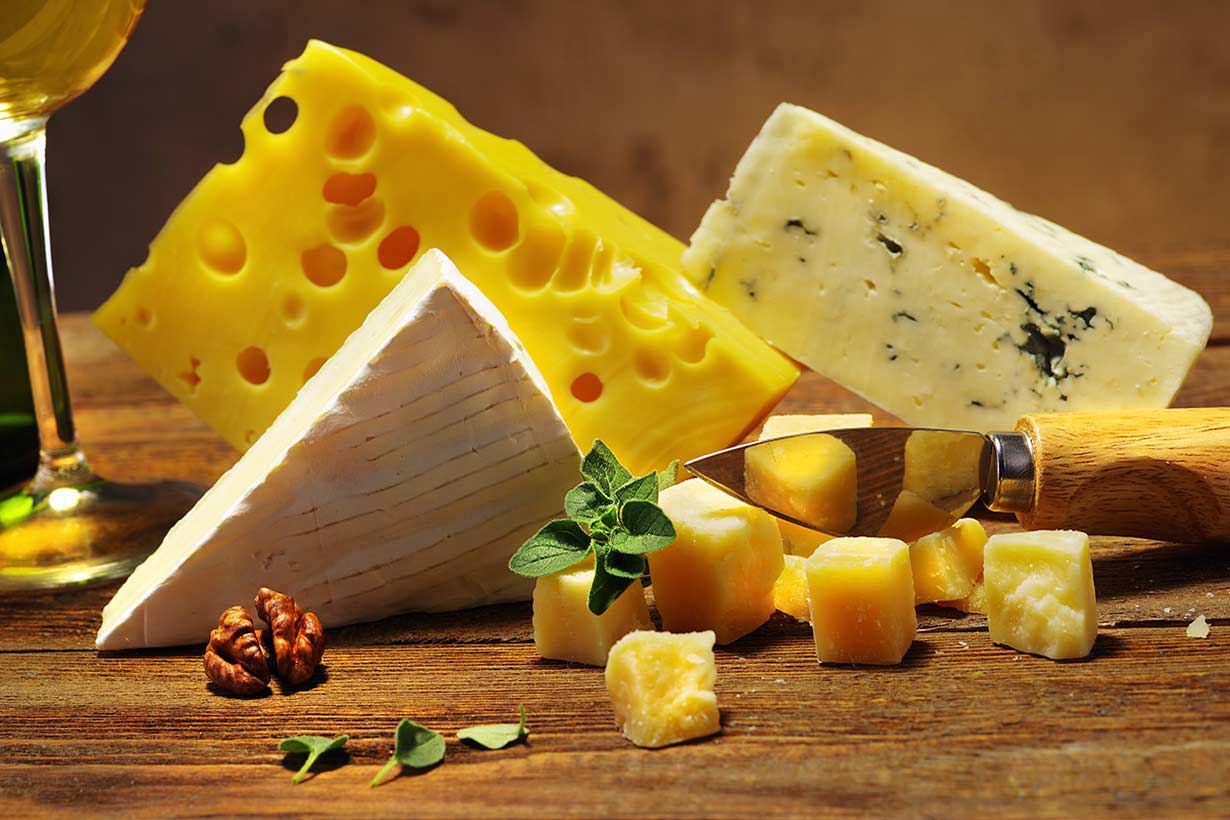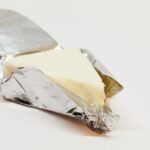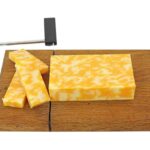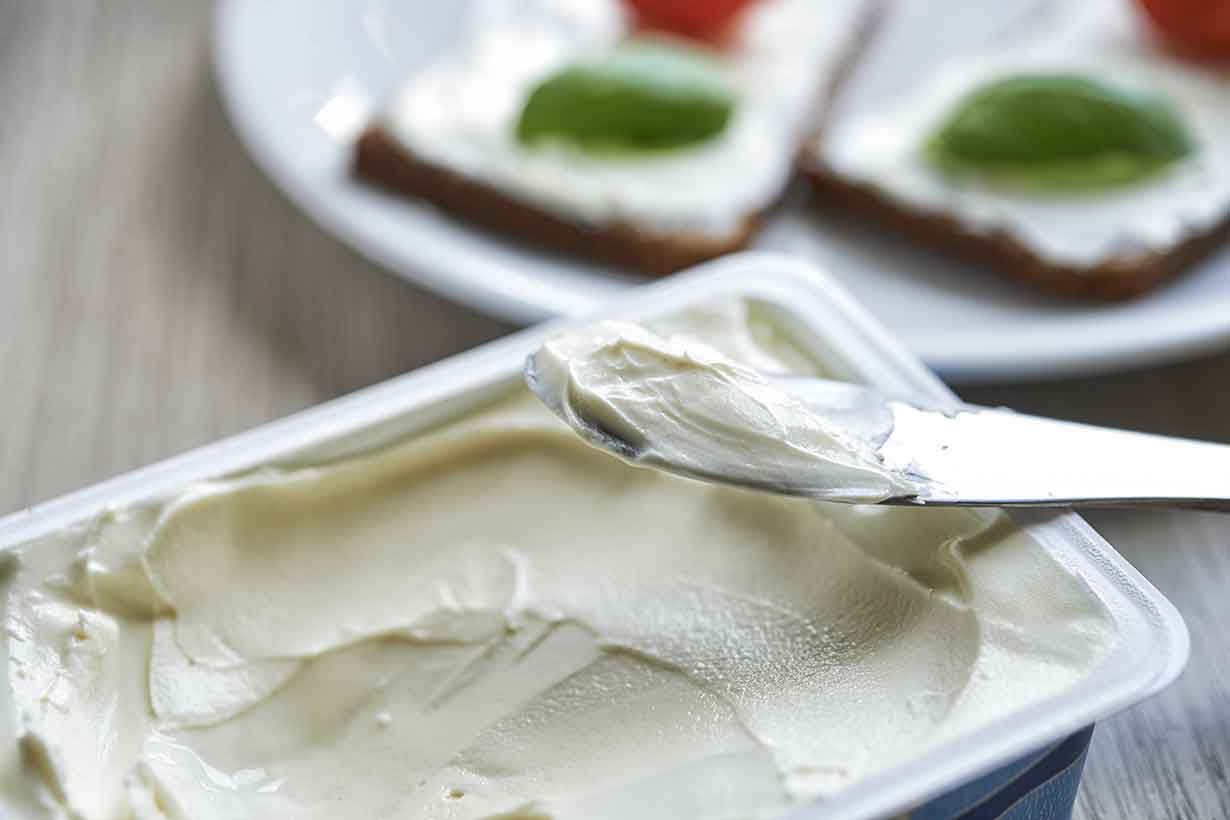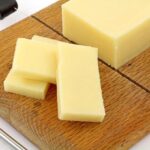American cheese is famous worldwide for its iconic appearance and mild creamy flavor.
However, what exactly is American cheese, and how does it compare to regular cheese?
This article examines the nutritional properties of American cheese and whether or not it’s a “healthy” choice.
Table of contents
What Is American Cheese?
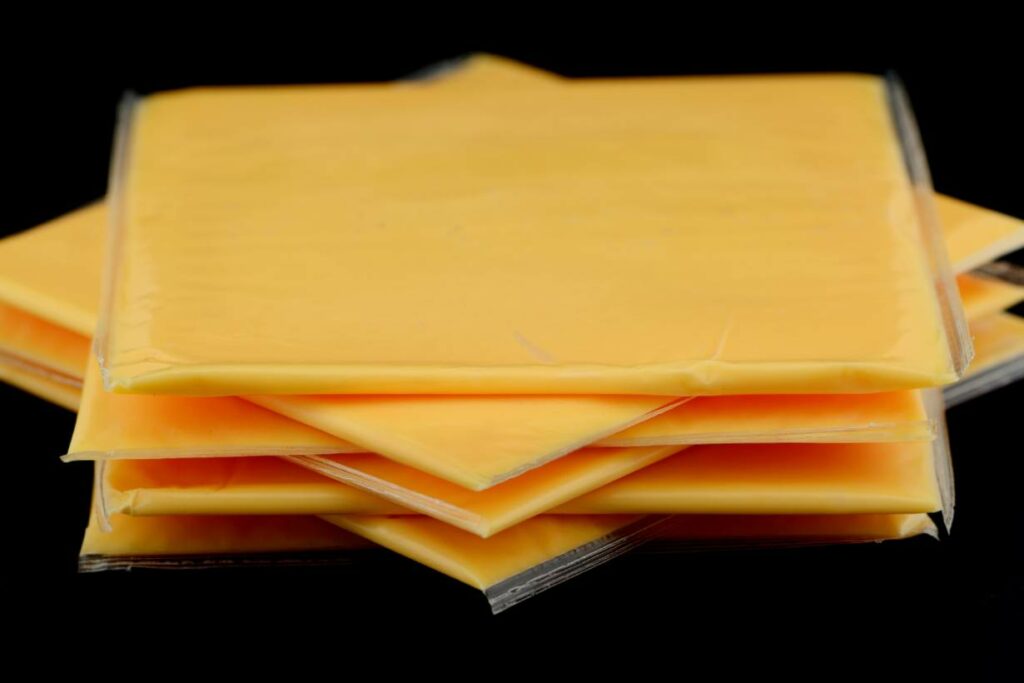
The image above shows what American cheese looks like, and it will be an image that most people recognize.
American cheese is also known by names such as ‘processed cheese,’ ‘American singles,’ ‘American slices,’ and ‘cheese slices.’
This processed cheese product has a mild yellow-to-orange color and a medium texture.
It melts quickly, and we can see it in many fast food products, most notably Mcdonalds’ burgers.
Regarding its taste characteristics, American cheese has a very mild and creamy flavor, and it is saltier than most other cheese. The product is usually sold in packs containing 10, 20, 50, 100+ slices, or anything in between.
The USDA refers to the cheese as ‘Pasteurized Process American Cheese’ (1).
What Ingredients Does It Contain?
American cheese undergoes more processing than traditional cheese options like Cheddar or Gouda.
On this note, traditional cheese typically contains four ingredients: milk, a starter culture, salt, and enzymes (2).
However, American cheese usually contains 5-10 additional ingredients to this.
For example, Kraft’s ‘American Singles’ is one of the most famous American cheese products. This particular product contains the following ingredients:
- Cheddar Cheese (milk, cheese culture, salt, enzymes)
- Water
- Milkfat
- Sodium citrate (emulsifier, flavoring/preservative)
- Calcium phosphate (emulsifier/provides calcium)
- Salt
- Sodium phosphate (emulsifier)
- Sorbic acid (preservative)
- Oleoresin paprika (coloring)
- Annatto (coloring)
- Vitamin D3
- Sunflower lecithin (emulsifier)
As this ingredients list shows, American cheese can contain around ten additional ingredients to regular cheese.
How Is It Made?
The production process of American cheese is reasonably straightforward.
Here is a quick summary based on publications from the USDA and the EPA (1, 3).
First, regular cheese (often Cheddar) is cleaned and checked for impurities.
After this check, the cheese is ground down in commercial grinders and combined with additional ingredients. The cheese mixture is then heated at a temperature higher than 165°F (73.9°C).
At this stage, the cheese mixture separates into fat and serum. Thus it needs to bind together to form a solid mass again.
For this purpose, emulsifiers are added to the mixture and mixed well.
Finally, while it still looks like a paste, the cheese mixture is quickly molded to the correct shape and size and then packaged.
What Nutrients Does American Cheese Provide?
USDA data shows the following nutrients in a 21-gram slice of American cheese (4).
All daily values have been calculated by combining the USDA data with the FDA’s recommended daily values (5).
Nutrition Facts
| Name | Amount | % Daily Value |
|---|---|---|
| Calories | 65 kcal | |
| Carbohydrates | 1.86 g | 0.7% DV |
| Fiber | 0 g | 0% DV |
| Sugars | 1.31 g | |
| Fat | 4.85 g | 6.2% DV |
| Saturated | 2.71 g | 13.6% DV |
| Monounsaturated | 1.19 g | |
| Polyunsaturated | 0.21 g | |
| Omega-3 | 0.02 g | |
| Omega-6 | 0.17 g | |
| Protein | 3.38 g | 6.8% DV |
| Cholesterol | 16.4 mg | 5.5% DV |
Vitamins
- Vitamin B12: 13.3% DV
- Riboflavin (B2): 6.8% DV
- Vitamin D: 6.8% DV
- Vitamin A, RAE: 6.3% DV
- Vitamin B6: 1.5% DV
- Choline: 1.4% DV
- Vitamin E: 1.2% DV
- Folate, DFE: 0.9% DV
- Thiamin (B1): 0.7% DV
- Vitamin K: 0.5% DV
- Niacin: 0.2% DV
Minerals
- Calcium: 22.3% DV
- Phosphorus: 12.9% DV
- Sodium: 11.7% DV
- Selenium: 6.2% DV
- Zinc: 4.2% DV
- Magnesium: 1.7% DV
- Potassium: 1.3% DV
- Iron: 1.1% DV
- Copper: 0.7% DV
How Does American Cheese Differ From Regular Cheese?
As previously mentioned, traditional cheese uses only four ingredients in its production.
In contrast, American processed cheese contains cheese that has been ground and mixed with multiple additional ingredients.
How do they compare nutritionally?
The following table shows the basic nutrition facts for American cheese compared to regular Cheddar cheese per 100 grams. The source of nutritional data is the USDA (4, 6).
| Nutrient | American (Processed) Cheese | Cheddar Cheese |
|---|---|---|
| Calories | 307 kcal | 403 kcal |
| Carbohydrates | 8.85 g | 3.37 g |
| Fiber | 0 g | 0 g |
| Sugars | 6.24 g | 0.48 g |
| Fat | 23.1 g | 33.3 g |
| Saturated | 12.9 g | 18.9 g |
| Protein | 16.1 g | 22.9 g |
| Cholesterol | 78 mg | 99 mg |
| Sodium | 1280 mg | 653 mg |
Here is a quick summary of the main differences:
- American cheese contains lower calorie, fat, saturated fat, and protein levels than Cheddar but more carbohydrate and sugar.
- Compared to Cheddar, American cheese contains nearly double the amount of sodium.
- One main reason American cheese contains fewer calories and fat is its water content. Since water is the most significant additional ingredient it contains, it naturally has fewer calories than regular cheese.
Benefits of American Cheese
Despite being a heavier processed variety of cheese, American cheese still has some benefits.
Here are some of the main positive traits of this cheese product.
Micronutrient Provision
American cheese provides a good source of vitamins and minerals. In this regard, just one 21-gram slice offers more than 10% of the daily value for vitamin B12, calcium, and phosphorus (4, 5).
Calcium and phosphorus are essential for maintaining good bone health (6, 7).
Vitamin B12 plays a vital role in producing DNA and red blood cells (8).
Shelf-Life
While it is not a health benefit, another positive characteristic of American cheese is its long shelf-life.
For instance, an unopened slice of American cheese can last for several months (depending on its label expiry date) when refrigerated.
Since each slice has individual wrapping, there’s no rush to finish a pack of cheese once first opened either.
Convenience
American cheese is very convenient; it comes individually wrapped as a ready-sliced serving and is ready to use in food.
Also, the cheese melts easily, which allows it to be used in various recipes that call for melted cheese.
Downsides
The additional ingredients and further processing of American cheese mean the product has some downsides.
Saturated Fat Content
American cheese is moderately high in saturated fat at 2.71 grams per slice and 12.9 grams per 100 grams per slice (4).
The Dietary Guidelines for Americans 2020-2025 recommend limiting saturated fat to 10% of total calories. Based on a 2000-calorie diet, this would be approximately 200 calories, about 22 grams of saturated fat (9).
With this in mind, there are some nuances to consider regarding the effect of saturated fats in different foods.
For example, higher saturated fat intake tracks with increased cardiovascular risk in large observational studies (10, 11, 12).
However, systematic reviews show that cheese, which is high in saturated fat, has neutral or inverse associations with cardiovascular risk (13, 14).
It is thought that the food matrix of cheese might be responsible for this apparent contradiction.
Since cheese contains an intact milk fat globule membrane (MFGM), it doesn’t have the same impact on lipids (cholesterol) as butter and other saturated fats (15, 16, 17).
On the downside, it is unlikely that processed American cheese would have this same benefit. This is because it contains added milkfat, an ingredient made from butter or cream. Milkfat is obtained through a process that removes the water and everything but the fat from the starting ingredient (18).
Very High In Sodium
American cheese contains high levels of sodium due to the added salt.
Regular cheese is moderately high in salt, but American cheese contains approximately twice the amount per gram.
The recommended daily value for sodium is 2300 mg, while just one slice of American cheese provides 269 mg (4).
A high dietary sodium intake can raise the risk of developing high blood pressure (19, 20, 21).
Contains Less Protein Than Most Cheese
When we think about cheese, its protein content is often touted as a benefit.
However, American cheese contains significantly lower amounts of protein than lesser-processed cheese.
For instance, Cheddar cheese offers 22.9 grams of protein per 100 grams (6).
In contrast, American cheese provides only 16.1 grams of protein – approximately 30% less (4).
How To Use American Cheese
The traditional way to use American cheese is to add a slice to a sandwich or a burger.
However, people use it in different ways around the world.
Here are some ways in which people use American cheese:
- In toasted sandwiches and as a burger filling
- Mixed into ramen noodles
- Melted into pasta dishes
- Melted into soups and stews
- To make mac and cheese
- With omelets and scrambled eggs
- As a (melted) ingredient in homemade dips
For those who enjoy the taste, it can also be eaten alone like other individually-wrapped cheese snacks, such as Babybel and String Cheese.
Common Questions
Here are the answers to some common questions about American cheese to help summarize.
Traditional cheese contains four ingredients, whereas American cheese contains 10+ ingredients. The two are different, but American cheese does contain real cheese as its primary ingredient.
There are likely numerous names for American cheese, depending on the country. However, ‘processed cheese’ is a common one. Other typical names include ‘American singles’ and ‘American slices.’
No, American cheese does not contain plastic. It is a sometimes seen myth, but such claims are misinformation.
The amount of real cheese in American cheese will depend on the brand and the particular product. However, the U.S. Food & Drug Administration (USDA) mandates that any product using the name ‘American cheese’ must contain at least 51% real cheese. We can see this in their Code of Federal Regulations for cheeses and related cheese products in section 133.124(5): “The weight of the cheese ingredient constitutes not less than 51 percent of the weight of the finished cold-pack cheese food” (22).
Yes, it is possible to buy non-fat varieties of American cheese. Their typical nutritional profile per 21-gram slice is as follows: 31 calories, 2.46g carbohydrates, 0.21g fat, and 4.77g protein (23).
Thinly-sliced Cheddar or other medium cheeses like Gouda or Swiss cheese are adequate substitutes.
Final Thoughts: Is American Cheese a Healthy Choice?
American cheese has some benefits and downsides.
It is a convenient protein, vitamin, and mineral source but contains less of these nutrients than real cheese.
On the other hand, it has a higher sodium content than regular cheese and is high in saturated fat.
Overall, American cheese can fit into a well-formulated diet for those who enjoy the taste.
However, traditional cheese options offer more nutritionally.

